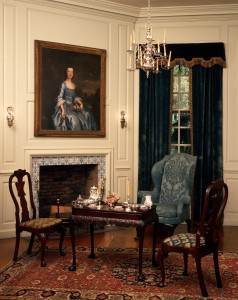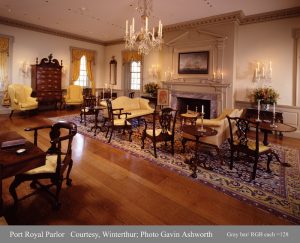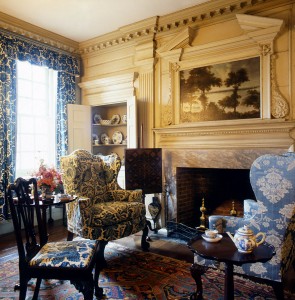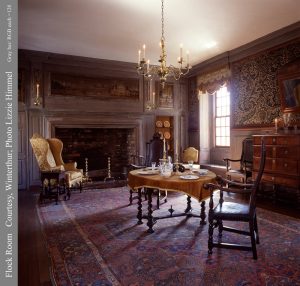We may receive a commission when you use our affiliate links. However, this does not impact our recommendations.
 In researching my next topic for this blog series, I was cruising the Winterthur web site. One of the things I noticed, as I sought various examples of a specific furniture form, was some great room shots from the museum. It dawned on me that these rooms are the epitome of “design in practice.”
In researching my next topic for this blog series, I was cruising the Winterthur web site. One of the things I noticed, as I sought various examples of a specific furniture form, was some great room shots from the museum. It dawned on me that these rooms are the epitome of “design in practice.”
All of the photos in this post are courtesy of Winterthur Museum, Gardens and Library.
When you look at the rooms you get a crash course in comparative design (in the photos it’s okay but in person it’s incredible). You can look at basic design principles and see how they were applied by different craftsmen in different ways. The great thing about Winterthur is, you not only get to compare one piece of furniture to another, but you see variation in design (and execution) in the entire environment.
 Look at the different objects in the room, including the architectural millwork. Compare a piece of metalwork in one photo to one in another; or a piece of China or a crown moulding detail. When you do you’ll start to see how regional tastes influenced design in the material culture of that region.
Look at the different objects in the room, including the architectural millwork. Compare a piece of metalwork in one photo to one in another; or a piece of China or a crown moulding detail. When you do you’ll start to see how regional tastes influenced design in the material culture of that region.
The great thing about Winterthur is you can compare countless examples of anything you want to study. If you want to see examples of Maryland chairs or tall-case clocks from Boston or 17th century Dutch candlesticks, the museum has enough examples that you can begin to get an idea of what was being made. From a comparative design point of view, however, the biggest problem with the museum is it’s hard to find poorly executed examples to help train your eye; nearly everything falls somewhere in the good to masterpiece range.
In the Port Royal Parlor, for example you can compare half a dozen or so side and armchairs. Most have ears and pierced splats (so, they’re Chippendale in nature…check out this post to find out why), and some are even based on the same design, but there are subtle differences. One chair has more sweep on the rear legs, another is broader opening up more space between the rear legs and the splat while yet another has curvier cabriole legs. Don’t want to study chairs? You can choose highboys, lowboys, easy chairs or even tea tables to study all in the same room.
 Another great reason to visit Winterthur often is to learn the specifics of the regional differences of furniture made in this country. When Henry Francis du Pont decided to open his childhood home to the public as a museum, he grouped furnishings primarily by locale in the rooms. There is some mixing of regions that occurs, but most of the rooms are predominantly from one area.
Another great reason to visit Winterthur often is to learn the specifics of the regional differences of furniture made in this country. When Henry Francis du Pont decided to open his childhood home to the public as a museum, he grouped furnishings primarily by locale in the rooms. There is some mixing of regions that occurs, but most of the rooms are predominantly from one area.
The galleries, however, are exhibits curated by theme and rotate frequently (in museum speak that means every year or so…museum time is outside the space-time continuum and moves at a much different rate). The only gallery that doesn’t change (much) is the Dominy workshop, which is a whole other subject except there are examples of Dominy work n the gallery with the clock and work shops.
 Winterthur is a tremendous resource for the study of pre-Industrial Revolution decorative arts. That means you’ll find objects (that’s museum speak for furniture and stuff…not only do they have their own time continuum but their own sub-language) in room setting ranging in creation date from about 1640 through about 1860. This means if you’re into Jacobean or William & Mary stuff, they’ve got rooms for you. And if you’re into Federal furniture, they’ve got that in abundance as well.
Winterthur is a tremendous resource for the study of pre-Industrial Revolution decorative arts. That means you’ll find objects (that’s museum speak for furniture and stuff…not only do they have their own time continuum but their own sub-language) in room setting ranging in creation date from about 1640 through about 1860. This means if you’re into Jacobean or William & Mary stuff, they’ve got rooms for you. And if you’re into Federal furniture, they’ve got that in abundance as well.
If you hadn’t figured it out by now, I’m a huge Winterthur fan because it’s a great training ground for furniture (and other decorative arts) design. Even if your passion runs to the contemporary it might be worth it to take a drive just a few minutes south of Wilmington, Delaware to learn about the evolution of design and how different craftsmen interpreted the designs of their day.
Here are a few more pics of some of the rooms at Winterthur.
Here are some supplies and tools we find essential in our everyday work around the shop. We may receive a commission from sales referred by our links; however, we have carefully selected these products for their usefulness and quality.




















Chuck
Thanks for the information. Your right, those du ponts knew how to live, Alfred’s, Nemours home is pretty amazing also along with the grounds around the estate. Just not enough time to take it all in on one visit.
Larry,
Most of the rooms are open to the public. The problem is, they only have a small fraction of them on the general admission tours. If you go back, contact them a couple of weeks or so in advance and tell them you want a private tour (the standard one and two hour tours are pretty good too, but go private for the best experience). It’s not cheap but it is more than worth it. I’ve taken clients on private tours and always requested a guide that specialized in furniture.
And, what Winterthur is to decorative arts, Longwood is to horticulture (though, the grounds are Winterthur are no slouch either). Those du Pont boys had it going on…
Chuck I just returned from Winterthur. An amazing place along with Longwood Gardens, but why aren’t more rooms in the museum at Winterthur available for public view? The guided tours do not allow much time to absorb all that is there.